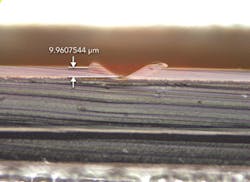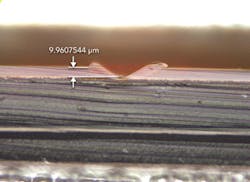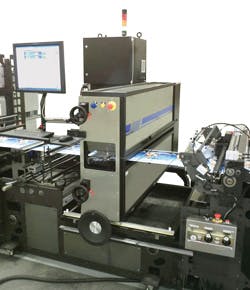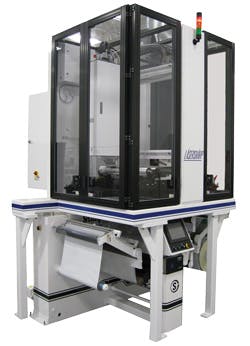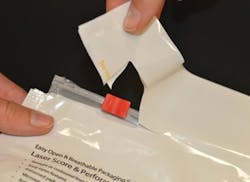Precision laser scoring for flexible film packaging
Laser-converting systems produce an accurate score with needed high speeds
Greg Jahr
The packaging industry has seen a rise in demand for features that add convenience and value to a package while maintaining the integrity of the product inside. With this increase, it becomes clear that packaging suppliers must adapt to the evolving needs of consumers by seeking out process solutions that deliver convenience and quality. Laser-scoring systems for flexible films deliver versatile value-added packaging features that enhance a product's ease of use without compromising the structural integrity of a flexible film.
Laser scoring of flexible films is a non-contact, clean processing solution that eliminates the need for mechanical tooling or consumables. A fully digital workflow markedly reduces production downtime, as pattern or design modifications can be made instantaneously. Laser modules can easily be integrated into new material handling systems or can be retrofitted to existing systems on a production floor. These laser systems are capable of precise scoring processes that add accurate features not obtainable through mechanical methods.
Advancements in scoring
Today's high-quality laser systems provide the ability to precisely and consistently score flexible films at controlled depths. The key to this technology involves the advanced control software of a laser system, which constantly monitors and adjusts the laser's power to ensure a consistent score depth even at varying web speeds. Score lines are created by vaporizing specified areas of a flexible film, creating a narrow channel in the material for a tear to follow. A laser weakens specific layers of a material to produce score lines without compromising the barrier properties of a flexible film. A digital workflow provides versatility and the ability to instantly adjust to varying specifications and materials, without the need to replace tooling for different jobs.
During the thermal process of laser scoring, vaporization and melting of the top layer(s) of flexible film occur as a result of the energy created by the laser beam. The taper, a V-shaped trough in the film, is created where material has been vaporized, thus generating the basis of a score line. On either side of the taper where heat is absorbed, a rollback or a slightly raised kerf is produced as the melted film transforms from a liquid state to a solid after cooling (Figure 1). Digital converting systems utilize vector files to manipulate the path of a laser beam so modifications can be made in real time. The result is a precisely placed score line that will tear cleanly every time, providing the end user with a convenience feature that promotes brand quality.
Laser source and material selection
Flexible materials best suited for laser processing are those with a narrow liquid-to-vapor temperature range. These include: polyester, polyethylene, polypropylene, PVDC barrier, polyolefin shrink films, nylon, and metalized films. Multilayer laminates are ideal for laser scoring, as one layer absorbs the laser beam energy for a precise score line while the laser beam transmits harmlessly through the other layer. Different materials absorb energy at varying rates and therefore vaporize at different temperatures. Adaptable laser processing systems adjust laser wattages to meet the diverse requirements of each flexible material.
Flexible packaging materials are ideally suited to lower power CO2 lasers, as these lasers are more than adequate for cost-effectively processing relatively thin films while maintaining a small footprint, low maintenance requirements, and high reliability. Typically, a CO2 laser with output power ranging from 40 to 300 W is standard for flexible packaging applications. CO2 laser outputs are in the infrared region of 10.25 and 10.6 microns. The laser beam is typically focused to a 100 µm diameter spot. Process areas can be configured from 70 mm x 70 mm to 500 mm x 500 mm.
Laser system features
When looking to add laser scoring to a manufacturing workflow, there are many laser configuration choices. Systems can be configured with one or multiple laser modules, up to as many as 25. Each laser module is independently controlled. These systems can stand alone or be retrofitted to existing equipment such as slitter rewinders or pouching lines. For example, the LaserSharp® PL40 system uses a small footprint to integrate straight line, down-web laser processing into pouching lines (Figure 2). Independent top and bottom laser modules can be positioned for precise inline scores or offset slightly for tabbed packaging applications. This system can easily be integrated into indexed or continuous processing zones, before or after folding operations.
Laser systems are also available to create laser-scored features in both down-web (machine) and cross-web (transverse) directions in straight line and contour-shaped patterns. Score lines can be precisely registered to printed details on a material. Registration sensors and vision cameras integrated directly within the laser processing system automatically control processing in response to print cues to ensure pattern accuracy. Straight line cross-web scoring, straight line down-web scoring, contoured machine direction scoring, and cross web patterns are all achievable in a single production run (Figure 3).
Additionally, many laser systems can accomplish multiple processes in the same production run at a single workstation, thereby increasing production efficiency. Laser scoring, slitting, and perforating can be achieved using one system. This type of system should be selected if additional features are to be added to packaging such as laser-etched product identification information or perforated breathable holes. It is important to keep in mind the end use or applications that are desired, as this will influence the laser system selection process.
Choosing a high-quality laser system
When looking for a high-quality laser system, several features must be considered. A consistent, repeatable score depth is key. Embedded controls technology is necessary to ensure accurate, managed depth scores by monitoring web speed and automatically adjusting laser power to adapt. Embedded controls of a high-end laser system will continuously monitor web speed and be able to adjust the laser's power to ensure consistent score depths at low speeds, during stops and starts of indexed processing, and across ramp-up to full production speed for continuous processing.
Additionally, microscopic analysis of laser-scored film, in conjunction with tensile strength testing, should be undertaken to ensure the laser system is delivering a functional score line without negatively affecting barrier layers of the film. Analyzing cross-sectional images of the film will reveal the precise depth of a scored line and the changes in which a substrate has undergone as a result of the heat of the laser process. When placed under a microscope, film processed by a low-quality laser system will exhibit variable score depths that have occurred throughout a change in web speed or gapped scores (as opposed to a smooth, continuous line) due to poor laser pulse control.
Installation and operation
Laser-scoring systems are low-maintenance and cost-effective manufacturing solutions. For installation, the water-cooled laser system requires a water chiller and purged, clean air. A high-quality system will have Class 1 work enclosures to eliminate the need for specialized safety precautions or glasses during normal operation. Integrated sensors, air panel, and heat exchanger manage the laser module's internal environment, eliminating condensation buildup while providing consistent laser-scoring results despite variations in external temperature. Monitoring these resources prevents damage to the laser and greatly reduces maintenance requirements. A touch-screen operator interface terminal facilitates ease of use during operation and job changeover.
The digital advantage
Applications for laser scoring are diverse and include easy-open tear strips for resealable standup pouches, pour spouts, microwavable packages, and peel-away windows. Advancements in laser-scoring technology no longer limit options simply to straight line, down-web processing, and thereby expand package design opportunities. For example, contour score lines (Figure 4) can be added to slider zipper pouches. When opened, the top material is discarded, leaving the sliding zipper exposed and allowing the consumer to more easily operate the slider and access the product inside.
While mechanical methods exist for scoring flexible materials, these options often yield an unreliable score line that unevenly tears and degrades a package without providing consumers an easy-open solution. Laser-converting systems produce a more accurate, functional score while matching the high speeds of today's manufacturing environments. An entirely digital workflow eliminates expensive machine downtime; production changeover is achieved simply by opening a new file. Laser-scoring systems deliver user-friendly and value-added features that protect the quality of the product inside. It is now easier than ever for brand owners and converters to improve product packaging with a multitude of cost-efficient laser-scoring options. ✺
Greg Jahr ([email protected]) is a sales manager at LasX Industries Inc. in St. Paul, MN, USA.
More Industrial Laser Solutions Current Issue Articles
More Industrial Laser Solutions Archives Issue Articles
